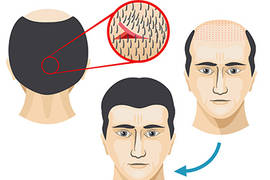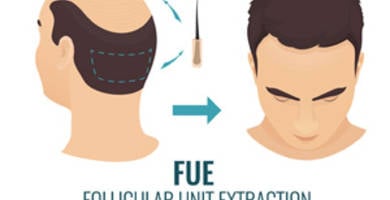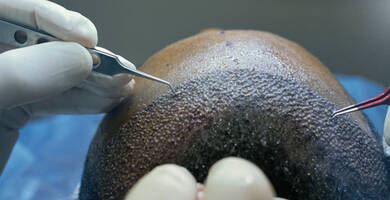Hair loss research: the future of the hair loss cure
By Prof. Dr. Soner Tatlidede 2019-08-05

Hair loss research is advancing every day, and experts believe that the future hair loss treatments will exceed the barriers of many cosmetic, medical and surgical methods used nowadays. Some new treatment methods, including hair cloning and gene therapy, will be able soon to cure hereditary patterned baldness permanently.
In fact, we don´t know how the future will be, but we can talk in advance about new techniques and research currently being studied that will be soon available for patients with hair problems. And in any case, whatever the future is, remember that you can find the best price for a hair transplant in Turkey.
Why spend money on a hair loss research study?
However, it is logical to ask: why is the scientific society making huge efforts on medical research and paying big funds on hair loss treatment, while other fatal diseases such as AIDS, cancer, diabetes or heart diseases are still waiting for solutions?
Human hair follicles are considered an important model to understand the biology of the human body; for example the organ system of our body, cell division, growth process and stages, our body immune reaction and response, or even the human genome.
In the hair growth cycle, hair follicles usually vanish totally after shedding phase, and normally new follicles develop and start growing in the next phase. Thus, each growth stage of the hair follicle give us an unique chance to apply different medical techniques, such as gene therapy or cloning method. When we discover the function of one part of the body, surely it has relation with something else, so what we learn in one medical field will surely be applied in other fields.
Diseases & alopecia
Diseases and some circumstances lead to cause provisional hair loss, called “non-scarring alopecia”, because of the diminutive organs that hair follicles consist of. The lost hair either regrows itself or with some intervention of chemical signals. Alopecia areata for example is considered a non-scarring alopecia. Some patients who suffer from alopecia areata have been able to regrow hair again, even after many years of suffering a constant hair loss.
There are also other cases for a non-scarring hair loss such, as exposing to chemotherapy and radiation treatments. Hair shafts that are pulled out of hair bulbs (located at the base of hair follicles, deep in the skin), do not permanently damage them. After being picked off, hair follicles will rest and start recovering; and after that a new hair bulb is grown, and as a result new hair will grow.
The cells that we find in the bulb are responsible for growing the hair shaft for 4 to 6 years during each hair growth round; but in the end of a full round, these cells seems to be destroyed, causing the contracting in the hair follicles volume in the resting phase. Future medications designed for the hair bulb cells will probably be effective to treat the alopecia areata, but also in reducing the hair loss caused by cancer treatments and stressful events.
Doctors call diseases that cause permanent hair loss “scarring alopecia”. These diseases affect hair growth by blocking the follicles and the growth of new hair. Some scarring alopecia, such as lupus erythematosus and lichen planopilaris, trigger an inflammatory immune response where white blood cells attack the bulge area of the hair follicle, which is located near the middle of the follicle.
The future of hair loss solutions
We can´t predict how hair loss solutions will be in the future; but nowadays, many hair loss medications have very limited effectiveness. Also, we don’t have enough information about why several diseases lead to hair loss. In many cases, we just treat the symptoms and not the causes of the disease, so usually the treatment for these diseases is not effective enough.
In fact, medications prescribed these days for androgenetic alopecia require a continuous use to guarantee its results; these medications usually have limited effect on some patients. Also, they need to carry the cost of these medications for long periods to have the wanted results.
In the future, hair loss treatments will be more effective because scientists and physicians will have a better understanding of how to control normal hair growth cycle, and how other conditions affect it. Also, they will develop new effective treatments to target hair loss causes and lower its side effects.
Dutasteride: the latest hair loss research
 Dutasteride is one of the promising future treatments. Currently, it is prescribed for treating benign prostate hyperplasia. It is produced by GSK (GlaxoSmithCline) under the commercial name Avodart. Like Finasteride, Dutasteride is a 5α-reductase inhibitor, and is taken as pills. It is shown that it inhibits chemical reactions that transform testosterone to dehydrotestosteron (DHT).
Dutasteride is one of the promising future treatments. Currently, it is prescribed for treating benign prostate hyperplasia. It is produced by GSK (GlaxoSmithCline) under the commercial name Avodart. Like Finasteride, Dutasteride is a 5α-reductase inhibitor, and is taken as pills. It is shown that it inhibits chemical reactions that transform testosterone to dehydrotestosteron (DHT).
High levels of DHT molecule cause prostate hyperplasia over years. In addition, it sends signals to reduce hair growth causing baldness in those who are genetically qualified with hair bulbs sensitive to dehydrotestosteron. Therefore, lowering DHT levels weakens these signals and reduces their effect on hair. The trick is to use a medication to inhibit 5α-reductase from converting testosterone to dehydrotestosteron: consequently, hair will grow again.
There are two different species of 5α-reductase inhibitor that converts testosterone to dehydrotstosterone. While Finasteride can be effective inhibiting 5α-reductase, Finasteride lowers DHT with an efficiency of 65-70%, while Dutasteride effect can reach 90% or more.
We hope that Dutasteride will be more effective than other described medications especially for females who have an inherited type of hair loss; also it will be good for men who did not achieve the expected results from Propecia. Dutasteride side effects are similar to Finasteride. Anyway, doses prescribed for hair loss treatment are not determined yet, and side effects appearance depends on the dose.
Topical treatments and new medications
Hair loss treatment research is advancing every day, and one method to achieve a high degree of effectiveness from hair loss medications, and at the same time decrease the side effects of these medications is the use of topical treatments. Hopefully, in the future we´ll have topical lotions that will apply to the head scalp: in this way, they will be more practical and effective to prevent the DHT from damaging the hair follicles cells.
Pills medications like Propecia (Finasteride) and Dutasteride affect DHT in a process that it is represented by many steps; first it will affect the DHT on the blood level, and after that will affect the amount of DHT in our head scalp; lastly this will lead to affect the DHT concentrations at cellular level.
Later in the future we hope that we will be able to affect the DHT level in hair follicles cells: this will lead us to increase our ability in controlling the hair loss and reduce the undesirable side effects. In the future, medications will be merged with shampoo or hair conditioners, and we will use these products to prevent the hair from falling. This method is similar to the fluoride in tooth paste that helps our teeth.
We also will develope hair loss medications to treat the baldness conditions that we are facing, other than genetic treatment. In the future we will use targeted medications designed to affect the follicles cells and their growth factors signals, by controlling the anagen stage -which is the first stage in the growing process- and at the same time blocking other signals that lead to shut off the growing process.
The future of surgical treatments
The surgical treatments for hair loss that are available today and we are using to limit the hair loss diseases, will be more effective in the future. Existing surgical ways are not able to produce a full head of thicker hair. The most apparent way to improve the surgical treatment is by using the cloning technique for the hair follicles.
The secret behind the importance of cloning technique is that if we have successful results in cloning hair follicles from the donor area, we will insure to have a lifetime result of hair growing and a limitless hair thickness. It will be possible to indirectly inject cloned follicles into the scalp, eliminating surgery altogether. If scientist can already clone an entire sheep: why can't we apply this cloning method on human hair follicles, and let it be a probable reality?
The answer is not that easy to explain, because it still needs some research about human cell biology, human genome and cell replication. Also there are different types of cloning that we probably will be able to apply on human hair follicles.
Cell biology
Cells are the basic elements of all living organisms. Cells in a multi-celled organism have specialized distinguishing their set up to most efficiently do their particular functions. Single cells in organisms work together with other similar cells in body tissue, or they may work together with different type of cells but in specialized structures like human organs.
For instance, in our hair follicles -which are a minimized organ- we can see that there are many different types of cells who are working together in order to grow the hair.
The anatomy of a maturated cell is centred on a structure called cell nucleus; this nucleus contains chromosomes composed of a double strands helix called DNA. DNA molecules are responsible to create different types of proteins by sending information, and this information is transferred to signals that allow this protein to do its function.
There are different types of proteins depending on their functions; for example, there are structural proteins like the keratin protein that we find in our hair; also there are other proteins responsible for sending messages between cells, like the DHT hormone; and other proteins who are responsible for converting proteins from one type to another type: an example of this is enzyme 5-alpha reductase.
Genetics
DNA molecules contain genes that are located in a way to encode a special type of proteins. All of these genes are guidelines for creating specific kinds of proteins. There are no genes for particular body properties, like pattern baldness or green eyes or curly hair; only guidelines for creating proteins. But other type of proteins are encoded by genes to determine the properties of this cells: for example, inherited hair loss, eye colour or hair curling.
Usually, many different types of genes and proteins work together to determine specific inherited body properties. A remarkable feature of the cells that we find in multi-celled organism is that each of one of them include in its chromosomes a full DNA blueprint of all the genes for all the proteins in the entire organism. However, single cells only use the information to produce the proteins that they need to do their specific function.

For instance, the cells that we find in the iris of the eye produce the protein that is responsible for expressing the green eyes property, but cannot use these proteins to express baldness or curly hair or any other genetic features.
On the other hand, all the information to create these types of proteins can be found in the iris cells of the eye, but it´s inefficient, the same as the information we find in hair follicles to create proteins for the green eyes feature. This is why unblocking the DNA information in older specialized cells is considered an important part of some cloning techniques.
Genetic hair loss
Androgenetic alopecia is one type of genetic of hair loss, which is considered to be a type of scarring alopecia; it minimizes hair follicles production over time, until no hair grows again. It has been suggested that the area called bulge is the one responsible for causing hair loss disease; this bulge is located in the hair follicle and its function is to regrow the hair in each new growth phase.
It is believed that many cells in the bulge produce the bulb cells at the start of each growing phase, cells that will form new hair. When the cells located in the bulge are damaged enough, this will lead to affect the growth of a new bulb in the hair follicle: as a result, no new hair will grow.
In the future, medications that are produced to target the bulge area in the hair follicle will be more effectively to treat the permanent hair loss than the surgical treatments; probably these medications will also be effective to treat the genetic pattern of hair loss.
Cell replication
In a rapidly growing embryo, cells replicate by splitting in half and then grow to full size again. This procedure is called cell mitosis, and each half of cell that splits contains a full and exact set of the organism's DNA and information. Later the embryo will grow into a more fully functioning organism, and every cell will begin to differentiate and get its own properties.
As cells get more specialized, cell replication will turn to special precursor cells which they are known as stem cells, which are very important in research for hair loss. Mature specialized cells do not replicate easily, maybe as a defense against cancer, which is featured by uncontrolled cell division. But all cells die by time, and new ones must replace them.
Every cell has special period of time to live: some of the cells last for days only, other may last for years and decades. The inability of differentiated cells to replicate themselves limits the body ability to repair itself, heal wounds and replace aging cells, and it makes cloning difficult.
Stem cells
In mature organism we can find some undifferentiated cells called stem cells, responsible for exchanging old or damaged specialized cells. We can find stem cells in every self-repairing tissue, but at the same time most of these stem cells are difficult to be distinguished in a mature organism.
Stem cells in mature organisms are similar to the embryonic ones; they can differentiate to any type of specialized cells. When stem cells are ineffective to create new cells, they will divide infrequently, which will decrease the danger of undesirable DNA mutations. But when these cells are ordered to make new cells of a special type, they will create short-lived cells (transit-amplifying cells) and then will engage in rapid cell mitosis to create specialized cells.
In conclusion, we can say that cells make up tissue and organs, that are engaged together to build the organism. The DNA that we find in organism cells contains genes that are responsible for creating proteins, and these proteins define specialized cell properties and tasks. Specialized cells in turn define the organism properties, including the inherited characteristics: for example, resistance to the hormone DHT.
Gene therapy
Gene therapy is a progressive and developed technique. In the future the gene therapy will be a method to solve the inherited hair loss. It is a process of modifying genes of existing cells in the body, and as result adjusting the cell function. This medical treatment is still in his first stages and there have only been a few experiments using gene therapy. However, this method is considered very important in the future to treat hair baldness.
Using the gene therapy technique requires to compile all molecular information in the DNA, and then start repairing the mutated places of the genome. The aim behind gene therapy is to exchange the DHT-sensitive cells in hair follicles for resistant cells, in order to have hair follicles that will continue to grow for a lifetime.
Gene therapy consists of several stages. The first step is to find the genes that you want to work on and that are responsible for the baldness; the next step is to determine how exactly these genes are changed, and give the information that will change the mutation and give the purpose you want. The third and last step is getting the target cells in the living organism to combine the new and improved genes, as alternatives for the old undesirable genes.
Gene identification
Figuring out which genes participate in the genetic condition to be changed is not any easy mission. Despite of all the progressing and development in mapping genes in recent years, we are still so far away from knowing all the details that we want about these genes.
Until now, we don’t have a strong background about what genes that are responsible for the hair growth cycle and what genes are affected to cause hair loss. The studies show that there are many different genes that are responsible to create the proteins that affect the hair follicles and let them be DHT-sensitive.
May be future studies will give us the chance to compare the genes and proteins in different hair follicles, but in the same person. In a study with a patient with androgenetic alopecia, some hair follicles will express the property of DHT-resistance (the ones at the back of the head scalp), while other hair follicles will express the property of DHT-sensitivity (at the front hairline).
Both hair follicles contain cells with similar DNA, but at the same time they show different properties. Distinguishing the responsible genes will not be that easy; after we differentiate these genes, we have to find a way to do some modifications on those genes to produce proteins that create DHT-resistant hair follicles. However, scientists have got some advances in gene identification.
Changing genes in living cells and living organisms
The last challenge of gene therapy is delivering the new and improved genes to the target cells, so that these cells use the delivered genes to make new proteins. Choosing the right targeted cells is the key point for gene therapy success. If mature cells are altered, the benefits of gene therapy go away after those cells are exchanged for new cells having the original and undesired DNA. To have a long-term effect, we must target stem cells.
The most common modified gene-delivery method involves using crippled viruses to insert required genes into the cells. Outside the laboratory, viruses are teeny organisms that are responsible for the infection of cells by replacing the cell's DNA with the DNA virus. After infecting the cell with that virus, the cell will begin to create the proteins expressed by the DNA virus.
Researchers are using this method to deliver the desirable DNA. First of all, they damage the DNA virus in order to not cause any harmful effects, but the DNA virus still will be able to insert its DNA into target cells. The desired genes are spliced onto the DNA virus. There are two ways to inject the viruses in the targeted cells: injecting the viruses directly to the stem cells, or cultivating the altered stem cells in a laboratory and placing them back into the organism.
More work and research is needed in identifying genes and determining exactly how to modify them to express the desired proteins; also in avoiding an immune reaction when the viruses are injected into the organism, getting enough quantity of target cells in order to take the altered DNA, and getting these cells to express the properties that are coded by the altered genes. But improvement is being made.
Conclusions
In conclusion, the future of hair loss treatment shows great promise in many aspects: from producing new medications such as Dutasteride, to advances in cloning and gene therapy.
But these different techniques are still under study and still far away from commercial use. Nowdays, treatments using cosmetic products, drugs such as Propecia, or surgical procedures like micro FUE transplant, are available right now. But, hair loss research is advancing every day, and surely soon new treatments will be available for all patients.










